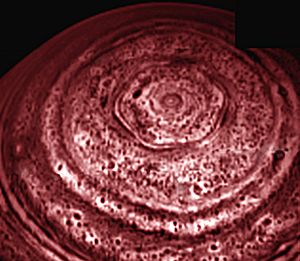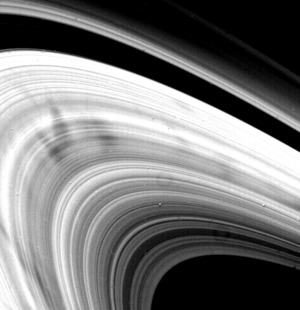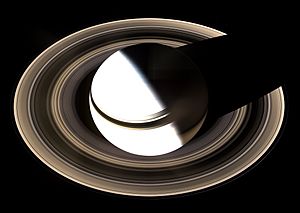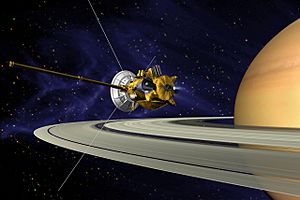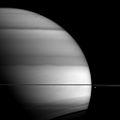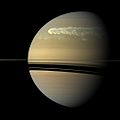Saturn facts for kids
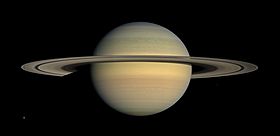 |
|||||||||||||
| Designations | |||||||||||||
|---|---|---|---|---|---|---|---|---|---|---|---|---|---|
| Adjectives | Saturnian | ||||||||||||
| Orbital characteristics | |||||||||||||
| Epoch J2000 | |||||||||||||
| Aphelion | 1,513,325,783 km 10.115 958 04 AU |
||||||||||||
| Perihelion | 1,353,572,956 km 9.048 076 35 AU |
||||||||||||
| 1,433,449,370 km 9.582 017 20 AU |
|||||||||||||
| Eccentricity | 0.055 723 219 | ||||||||||||
| 10,832.327 days 29.657 296 yr |
|||||||||||||
| 378.09 days | |||||||||||||
|
Average orbital speed
|
9.69 km/s | ||||||||||||
| 320.346 750° | |||||||||||||
| Inclination | 2.485 240° to Ecliptic 5.51° to Sun’s equator 0.93° to Invariable plane |
||||||||||||
| 113.642 811° | |||||||||||||
| 336.013 862° | |||||||||||||
| Known satellites | around 200 observed (61 with secure orbits) | ||||||||||||
| Physical characteristics | |||||||||||||
|
Mean radius
|
58,232±6 km | ||||||||||||
| Flattening | 0.097 96 ± 0.000 18 | ||||||||||||
| 4.27×1010 km2 83.703 Earths |
|||||||||||||
| Volume | 8.2713×1014 km3 763.59 Earths |
||||||||||||
| Mass | 5.6846×1026 kg 95.152 Earths |
||||||||||||
|
Mean density
|
0.687 g/cm3 (less than water) |
||||||||||||
| 10,44 m/s2 0.914 g |
|||||||||||||
| 35.5 km/s | |||||||||||||
|
Sidereal rotation period
|
0.439–0.449 days (10 h 32 – 47 min) |
||||||||||||
|
Equatorial rotation velocity
|
9.87 km/s 35 500 km/h |
||||||||||||
| 26.73° | |||||||||||||
|
North pole right ascension
|
2 h 42 min 21 s 40.589° |
||||||||||||
|
North pole declination
|
83.537° | ||||||||||||
| Albedo | 0.342 bond 0.47 geom |
||||||||||||
|
|||||||||||||
| +1.2 to -0.24 | |||||||||||||
| 14.5" – 20.1" (excludes rings) |
|||||||||||||
| Atmosphere | |||||||||||||
| 59.5 km | |||||||||||||
| Composition by volume | ~96% hydrogen (H2) ~3% helium ammonia water ammonium hydrosulfide (NH4SH) |
||||||||||||
Saturn is the sixth planet from the Sun in our Solar System. It is the second largest planet, right after Jupiter. Like Jupiter, Uranus, and Neptune, Saturn is a "gas giant". This means it is mostly made of gases.
Inside Saturn, there is likely a core made of iron, nickel, silicon, and oxygen compounds. This core is surrounded by layers of metallic hydrogen, then liquid hydrogen and liquid helium. The very outer part is a gaseous layer.
Saturn has 62 known moons that orbit it. 53 of these moons have official names. The biggest moon is Titan, which is even larger than the planet Mercury in size. Titan is the second-largest moon in the entire Solar System. The largest moon is Jupiter's moon, Ganymede. Saturn is also famous for its amazing system of rings. These rings are mostly made of ice, with smaller amounts of rocks and dust. Saturn is about 1.4 billion km (869 million mi) away from the Sun. It takes Saturn about 29.6 Earth years to travel once around the Sun.
Saturn got its name from the Roman god Saturnus. In Greek mythology, he was known as Kronos. Saturn's symbol, ♄, looks like Saturnus's sickle.
Contents
Saturn's Physical Features

Saturn is shaped like a flattened ball, called an oblate spheroid. This means it is a bit squashed at its poles (top and bottom) and bulges out around its middle, or equator. The distance across Saturn at its equator is about 120,536 km (74,897 mi). However, the distance from its north pole to its south pole is 108,728 km (67,560 mi). This 9% difference is because Saturn spins very fast, completing one rotation every 10.8 hours.
Saturn is the only planet in our Solar System that is less dense than water. Even though its core is very dense, its outer layers are gaseous. This makes Saturn's average density about 0.69 grams per cubic centimeter. This is less than the density of water. Imagine if you could put Saturn in a giant swimming pool; it would actually float!
Saturn's Atmosphere
The outer part of Saturn's atmosphere is mostly hydrogen (about 96%) and helium (about 3%). It also has small amounts of methane and ammonia. Tiny traces of other gases like acetylene, ethane, and phosphine are also present.
Saturn's clouds form patterns of bands, similar to those seen on Jupiter. However, Saturn's clouds are much fainter, and the bands are wider near the equator. The lowest cloud layer is thought to be made of water ice. It is about 10 km (6 mi) thick and has a temperature of about 250 K (-23°C). Above this, there is a layer of ammonium hydrosulfide ice, about 77 km (48 mi) thick. Higher still is a layer of ammonia ice clouds, about 80 km (50 mi) thick. The very top layer is made of hydrogen and helium gases. It stretches between 200 km (124 mi) and 270 km (168 mi) above the water clouds.
Auroras, like the northern lights on Earth, can also be seen in Saturn's upper atmosphere. The temperature at Saturn's cloud tops is extremely cold, around 98 K (-175°C). But inside the planet, temperatures are much higher. This is because of the heat produced from Saturn's core. Saturn's winds are some of the fastest in the Solar System. They can reach speeds of 1,800 km/h (1,118 mph), which is ten times faster than winds on Earth.
Storms and Spots on Saturn
Saturn's atmosphere also has oval-shaped clouds, much like the famous spots on Jupiter. These oval spots are huge storms, similar to cyclones on Earth. In 1990, the Hubble Space Telescope spotted a very large white cloud near Saturn's equator. These types of storms are known as Great White Spots. They do not last long and only appear about every 30 Earth years. This usually happens during the summer solstice in Saturn's Northern Hemisphere.
Past Great White Spots were seen in 1876, 1903, 1933, and 1960. The 1933 storm was studied the most. Saturn's winds are the second fastest among the Solar System's planets, only slower than Neptune's. The Voyager spacecraft measured winds reaching 500 m/s (1,800 km/h). In 2007, images from the Cassini spacecraft showed Saturn's northern hemisphere looking bright blue. This color was likely caused by Rayleigh scattering, which is how Earth's sky looks blue.
Scientists have also found a warm polar vortex at Saturn's south pole. This is the only one of its kind known in the Solar System. While Saturn's normal temperatures are around -185°C, temperatures in this vortex can reach -122°C. This makes it the warmest spot on Saturn. In 2006, NASA reported that Cassini saw a "hurricane-like" storm at the south pole. This storm had a clear eyewall, which had never been seen on any planet other than Earth before. For example, Jupiter's Great Red Spot does not have an eyewall. This south pole storm might have been there for billions of years. It is as big as Earth and has winds of 550 km/h.
Inside Saturn: Its Core
Saturn's inside is similar to Jupiter's. It has a small, rocky core at its center, which is about the size of Earth. This core is extremely hot, reaching temperatures of 15,000 K (26,540°C). Saturn is so hot that it actually gives off more heat energy into space than it gets from the Sun. Above the core is a thick layer of metallic hydrogen, about 30,000 km (18,641 mi) deep. Above that, there is a region of liquid hydrogen and helium. The core is very heavy, with a mass about 9 to 22 times that of Earth's core.
Saturn's Magnetic Field
Saturn has a natural magnetic field, but it is weaker than Jupiter's. Like Earth's, Saturn's field is a magnetic dipole, meaning it has a north and south pole. What makes Saturn's field special is that it is perfectly symmetrical. It lines up exactly with the planet's axis. Saturn creates radio waves, but they are too weak for us to detect from Earth. Its moon Titan orbits in the outer part of Saturn's magnetic field. Titan's atmosphere releases plasma into the field from ionised particles.
Saturn's Rotation and Orbit
Saturn's average distance from the Sun is over 1.4 billion km (869 million mi). This is about nine times the distance from Earth to the Sun. It takes Saturn 10,759 days, or about 29.7 Earth years, to complete one orbit around the Sun. This is called Saturn's orbital period.
The Voyager 1 spacecraft measured Saturn's rotation speed. It found that the equator spins once every 10 hours and 14 minutes. Areas closer to the poles spin a bit slower, at 10 hours and 40 minutes. The planet's interior rotates in 10 hours, 39 minutes, and 24 seconds. This is called its rotational period.
Later, the Cassini spacecraft measured Saturn's rotation as 10 hours, 45 minutes, and 45 seconds. This was about six minutes longer than the Voyager measurements. Scientists calculate Saturn's rotation based on radio waves released by the planet. Cassini found that these radio waves seemed to slow down, which suggested the rotational period was increasing. However, scientists do not believe Saturn's rotation is actually slowing. Instead, they think the change might be due to how the magnetic field creates these radio waves.
Saturn's Amazing Rings
Saturn is most famous for its planetary rings, which are easy to see with a telescope. There are seven main named rings: A, B, C, D, E, F, and G. They were named in the order they were discovered, not their order from the planet. If you start from the planet and move outwards, the rings are D, C, B, A, F, G, and E.
Scientists believe the rings are made of material left over after a moon broke apart. A newer idea suggests it was a very large moon that mostly crashed into Saturn. This crash left a huge amount of ice to form the rings, and also some of Saturn's icy moons, like Enceladus.
History of Ring Discovery

The rings were first seen by Galileo Galilei in 1610 using his telescope. They did not look like rings to him. He called them "handles" and thought Saturn was three separate planets touching each other. In 1612, the rings seemed to disappear when they were edge-on to Earth, then reappeared in 1613. This confused Galileo even more.
In 1655, Christiaan Huygens was the first person to correctly identify that Saturn was surrounded by rings. Using a much stronger telescope, he wrote that Saturn "is surrounded by a thin, flat, ring, nowhere touching...". In 1675, Giovanni Domenico Cassini found that the rings were actually made of smaller ringlets with gaps between them. The largest gap was later named the Cassini Division.
In 1859, James Clerk Maxwell showed that the rings could not be solid. He proved they must be made of many small particles, each orbiting Saturn on its own. If they were solid, they would be unstable and break apart. James Edward Keeler used a spectroscope in 1895 to study the rings, which proved Maxwell's idea.
What the Rings are Made Of
The rings stretch from about 6,630 km (4,120 mi) to 120,700 km (75,000 mi) above Saturn's equator. As Maxwell proved, even though they look solid, the rings are made of tiny particles of rock and ice. They are only about 10 meters (33 ft) thick. These particles are made of silica rock, iron oxide, and ice. The smallest particles are like specks of dust, while the largest are the size of a house.
The C and D rings even seem to have a "wave" in them, like waves in water. These large waves are 500 meters (1,640 ft) high but move very slowly, about 250 meters (820 ft) each day. Some scientists think these waves are caused by Saturn's moons. Another idea is that a comet hitting Saturn in 1983 or 1984 created the waves.
The largest gaps in the rings are the Cassini Division and the Encke Division. Both can be seen from Earth. The Cassini Division is the biggest, measuring 4,800 km (2,983 mi) wide. When the Voyager spacecraft visited Saturn in 1980, they found that the rings are very complex. They have thousands of thin gaps and ringlets. Scientists believe this is caused by the gravitational force of some of Saturn's moons. The tiny moon Pan orbits inside Saturn's rings, creating a gap. Other ringlets keep their shape because of the gravity of shepherd satellites, like Prometheus and Pandora. Other gaps form because of the gravity of larger moons orbiting farther away. For example, the moon Mimas is responsible for clearing out the Cassini gap.
Recent information from the Cassini spacecraft shows that the rings have their own atmosphere. This atmosphere is separate from the planet's atmosphere. It is made of oxygen gas, created when the Sun's ultraviolet light breaks apart the water ice in the rings. Chemical reactions also happen between the ultraviolet light and water molecules, making hydrogen gas. The oxygen and hydrogen atmospheres around the rings are very spread out. Besides oxygen and hydrogen, the rings also have a thin atmosphere of hydroxide. This anion was found by the Hubble Space Telescope.
Mysterious Spokes in the Rings
The Voyager space probe discovered features that look like rays, called spokes, in Saturn's rings. These were also seen later by the Hubble telescope. The Cassini probe photographed the spokes in 2005. They look dark when sunlight hits them but appear light when seen against the unlit side of the rings. At first, scientists thought the spokes were made of tiny dust particles. However, new evidence suggests they are made of ice.
The spokes rotate at the same speed as Saturn's magnetosphere. This suggests they are connected to electromagnetism. But exactly what causes the spokes to form is still a mystery. They seem to be seasonal, disappearing during solstices and appearing again during equinoxes.
Saturn's Moons
Saturn has 53 named moons, and nine more that are still being studied. Many of Saturn's moons are very small. 33 of them are less than 10 km (6 mi) across, and 13 are less than 50 km (31 mi) across. Seven moons are large enough to be almost perfect spheres because of their own gravitation. These moons are Titan, Rhea, Iapetus, Dione, Tethys, Enceladus, and Mimas.
Titan is the largest moon, even bigger than the planet Mercury. It is the only moon in our Solar System that has a thick, dense atmosphere. Hyperion and Phoebe are the next largest moons, both over 200 km (124 mi) in diameter.
In December 2004 and January 2005, the Cassini−Huygens probe took many close-up photos of Titan. A part of this probe, called the Huygens probe, then landed on Titan. Named after the Dutch astronomer Christiaan Huygens, it was the first spacecraft to land in the outer Solar System. The probe was designed to float in case it landed in liquid.
Enceladus, the sixth largest moon, is about 500 km (311 mi) across. It is one of the few objects in the outer Solar System that shows volcanic activity. In 2011, scientists found an electric link between Saturn and Enceladus. This happens when ionized particles from volcanoes on Enceladus interact with Saturn's magnetic fields. Similar interactions cause the northern lights on Earth.
Exploring Saturn
Saturn was first explored by the Pioneer 11 spacecraft in September 1979. It flew as close as 20,000 km (12,427 mi) above Saturn's cloud tops. It took pictures of the planet and some of its moons, but the quality was not very good. Pioneer 11 discovered a new, thin ring called the F ring. It also found that the dark ring gaps appear bright when viewed towards the Sun. This showed that the gaps are not completely empty. The spacecraft also measured the temperature of the moon Titan.
In November 1980, Voyager 1 visited Saturn. It took much clearer photographs of the planet, its rings, and moons. These photos allowed scientists to see the surface features of the moons. Voyager 1 flew close to Titan and gathered a lot of information about its atmosphere. In August 1981, Voyager 2 continued to study the planet. Photos from Voyager 2 showed that changes were happening in Saturn's rings and atmosphere. The Voyager spacecraft discovered several moons orbiting close to Saturn's rings, and also found new gaps in the rings.
On July 1, 2004, the Cassini−Huygens probe entered orbit around Saturn. Before that, it flew close to Phoebe, taking very high-quality photos of its surface and collecting data. On December 25, 2004, the Huygens probe separated from the Cassini probe. It then moved down towards Titan's surface and landed there on January 14, 2005. It landed on a dry surface but found that large bodies of liquid exist on the moon.
The Cassini probe continued to collect data from Titan and several of Saturn's icy moons. It found evidence that the moon Enceladus had water erupting from its geysers. In July 2006, Cassini also proved that Titan had hydrocarbon lakes near its north pole. In March 2007, it discovered a large hydrocarbon lake the size of the Caspian Sea near Titan's north pole.
Cassini observed lightning on Saturn starting in early 2005. The lightning was measured to be 1,000 times more powerful than lightning on Earth. Astronomers believe that the lightning seen on Saturn is the strongest ever recorded.
Images for kids
-
Methane bands circle Saturn. The moon Dione hangs below the rings to the right.
-
Galileo Galilei saw Saturn's rings in 1610 but did not know what they were.
-
A portrait of Saturn from the Hubble Space Telescope in 2019.
See also
 In Spanish: Saturno (planeta) para niños
In Spanish: Saturno (planeta) para niños


